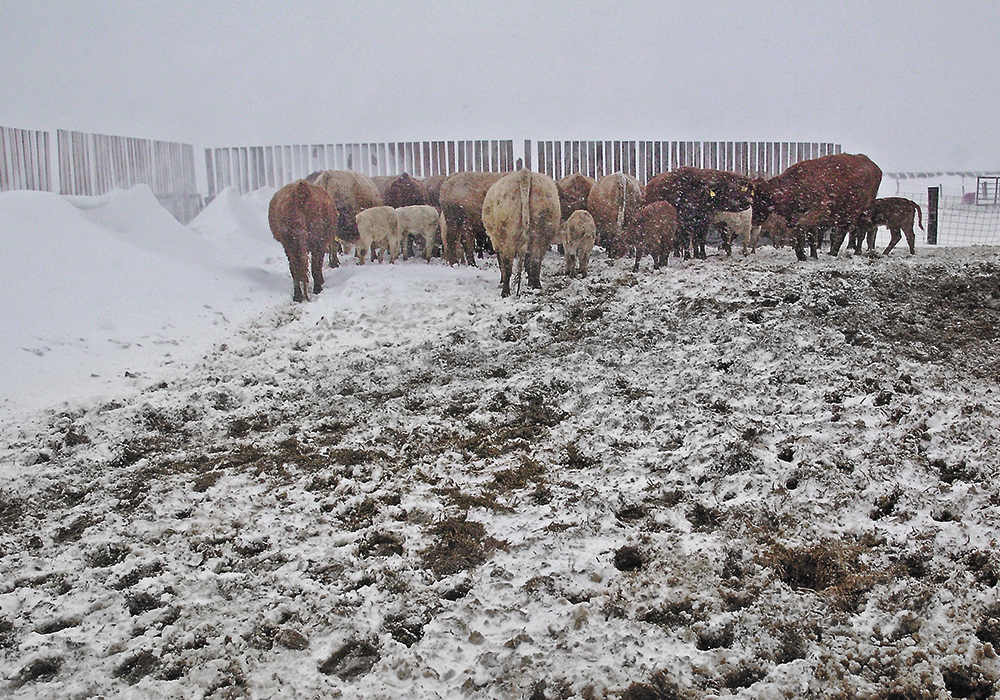Cattle producers scramble to keep animals safe as snow, rain and high winds hit the province again during calving season
Eastern prairie cattle producers spent a second weekend in a row scrambling to keep newborn calves and their mothers safe from blizzard, sleet and soaking rains, with more rain in the forecast for April 28-30.
“They’re spent, mentally and physically exhausted,” Carson Callum, general manager of Manitoba Beef Producers, said April 25.
“Overall, the added moisture will be a good thing as we get into the spring and the growing season, but this (heavy rain and snow) combined with the cold is making it really challenging.”
Read Also

Volatile temperatures expected for this winter
DTN is forecasting a lot of temperature variability in the Canadian Prairies this winter. Precipitation should be close to average.
Crop producers were less immediately affected by the storms but saw their likely seeding dates pushed back even further.
However, few complained about the much-needed moisture that now virtually guarantees the new crop will have what it needs to germinate.
“It’s just helping to recharge the soil moisture,” said Chuck Fossay, who farms in the Starbuck area west of Winnipeg.
In most years, farmers in his area struggle with too much moisture and saturated conditions. That situation applies up and down the Red River Valley in most years, as well as in parts of southwestern Manitoba.
This spring, despite the localized overland flooding and overflowing ditches in areas with frozen culverts, most crop farmers are happy for the moisture after surviving drought conditions last summer.
“Last year, we were seeding into really, really dry ground. It took the crop a long time to grow,” said Fossay.
However, anxiety is growing over seeding delays. In the Red River Valley farmers should already be seeding, and farmers to the west should be on the verge of it in an average year.
“We’re just setting ourselves up for a late planting season on the eastern Prairies,” said Bruce Burnett, lead crop conditions analyst at MarketsFarm.
“It is a number of weeks away.”
Two weeks of cold and wet weather have seen snow, sleet and rains hit an area covering Manitoba and southeastern Saskatchewan, the product of successive “Colorado low” weather systems, but areas west of the storm zones couldn’t be more different.
“For the bulk of the Prairies, this doesn’t mean anything,” said Burnett.
“The western Prairies are still desperately dry.”
Unless needed moisture arrives immediately, farmers on much of the Prairies will be seeding into dry soils that threaten germination, while others are anxiously waiting for soils to warm and dry.
With another Colorado low heading north, there is little prospect that any seeding will happen on the eastern Prairies soon.
Growers aren’t panicking, however. Once warmer weather returns and moisture soaks in, there is a good chance for quick seeding and crop emergence setting up the crop better than last year.
A year ago, crops seeded into dry soils emerged slowly and patchy, which provided a lasting buffet for insect pests like flea beetles. Later-seeded crops tend to emerge faster as they benefit from more daily heat.
“I’m hoping that this year there will be lots of moisture in the topsoil, and with some nice warm weather the seed will pop out of the ground in four or five days,” said Fossay.
Cattle producers will be long term beneficiaries of all this new moisture. Dugouts will refill, grass will grow and pastures can begin a long process of recovery from drought. However, before farmers can think about that they have to get their calves through this period of heavy storms.
“If you’re spring calving, these are just the worst conditions,” said Burnett.
“Two late season winter storms are not good.”
Callum urged farmers who are worn out by the impact of these storms and the upset feelings that can arise from struggling to take care of calves in severe weather to talk to other producers and call the Farm, Rural and Northern support line if they feel overwhelmed.
“It’s hard on producers because they care so much for the animals,” said Callum.
If farmers can get their animals through this challenging period, they should be able to enjoy a much better spring and a better outlook for the summer.
“Last year at this time we were very dry and dugouts were approaching empty,” said Callum.
“It’s short-term exhaustion, short-term pain.”
















